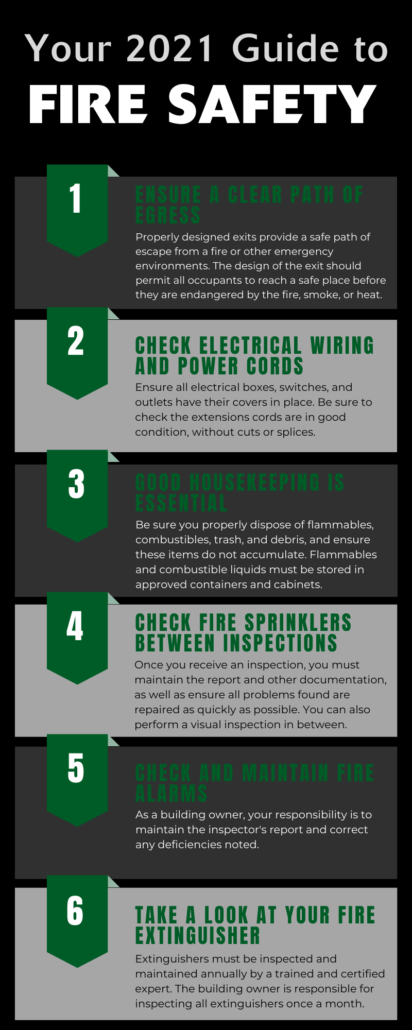YOUR 2021 FIRE PROTECTION CHECKLIST
IT’S A NEW YEAR… YOU’VE ALREADY SKIPPED THE GYM DON’T SKIP ON YOUR FIRE PROTECTION. HERE’S A CHECKLIST TO HELP
We’re four days into the new year, if you haven’t already ditched your resolutions, you’re amazing. We’re not going to lie… we snuck a piece of chocolate cake after dinner last night. While a piece of chocolate cake, or a day off of the gym won’t seriously harm your wellbeing, there is one resolution you can’t forget about- fire protection for your building.
This year, it’s time to make fire protection a top priority. That being said, we’ve come up with a few items that should be on the top of your mind if you’re committed to fire safety.
FIRST, ENSURE YOUR BUILDING HAS A CLEAR PATH OF EGRESS/ EXIT.
Identifying the ‘means of egress’ from your building is essential to keeping your employees safe from harm. Properly designed exits provide a safe path of escape from a fire or other emergency environments. The design of the exit should permit all occupants to reach a safe place before they are endangered by fire, smoke, or heat. The goal of an effective means of egress is to get everyone out of hazardous areas in the shortest amount of time possible.
A FEW COMPONENTS MAKE UP THE MEANS OF EGRESS, INCLUDING EXIT ACCESS, EXIT, AND EXIT DISCHARGE.
- Exit access is the travel path or area between where a person is located and an exit.
- Exit is the portion of the means of egress that is separated by construction or equipment from other areas of the building. Components of an exit include walls, floors, doors, etc. An exit may include vertical or horizontal means of travel, like stairways, ramps, and passageways. It is important to note that elevators are not accepted as exits!
- Exit discharge is the portion of a means of egress between the end of the exit and a public way or other safe places.
As a building manager or owner, it is important that you self-inspect these means of egress. In doing this, you need to make sure each component is easily identifiable, visible, accessible, and unobstructed. The door must operate in the direction of the exit so people won’t be trapped inside.
NEXT, CHECK YOUR ELECTRICAL WIRING AND POWER CORDS.
NFPA 70: National Electrical Code (NEC) ensures all wiring and electrical installations comply with regulations. Building owners and managers do not need to be an expert in electrical code, however there are a few things you should be on the lookout for to be cautious!
The first thing you should do to ensure your electrical wiring is safe is to ensure all electrical boxes, switches, and outlets have their covers in place. Also, be sure to check that extension cords are in good condition and free of any cuts or splices. Extension cords should never be a substitute for permanent wiring, they are only permitted to be used with temporary equipment.
Surge protectors must be connected directly to an outlet and, like extension cords, cannot be attached to the structure, extend through walls or the ceilings, be run under doors, or be covered by floor coverings.
The last item to check in the electrical wiring category is electrical panel boxes. Electrical panel boxes and main building disconnect must be identified and accessible for fire department personnel. All panels and breakers must be labeled and open spaces should have proper covers in place.
GOOD HOUSEKEEPING IS ESSENTIAL– NO WE’RE NOT TALKING ABOUT DUSTING AND MOPPING.
In the ‘fire safety’ sense, housekeeping refers to the general condition of the building and the items stored within it. Be sure you properly dispose of flammables, combustibles, trash, and debris, and ensure these items do not accumulate. Flammables and combustible liquids must be stored in approved containers and cabinets and should be clearly labeled to avoid accidental ignition.
Electrical, boiler and HVAC rooms cannot be used for storage and must remain clear of items that are not essential to the operation of the equipment within them.
ENSURE FIRE SPRINKLER SYSTEMS RUN EFFECTIVELY IN BETWEEN INSPECTIONS
Fire sprinkler systems must meet NFPA 25: Standard for the Inspection, Testing, and Maintenance of Water-based Fire Protection Systems requirements. These standards require that different parts of the sprinkler systems receive inspections in quarterly, semi-annual, annual, and five-year intervals.
The inspections are performed by the fire protection contractors and other qualified personnel. As a building owner or manager, you do not have to directly handle any of the actual inspections. However, as a building owner, there are a few things you can do to ensure these inspections run efficiently and effectively, starting with scheduling the inspection appointments when due!
Once you receive an inspection, you must maintain the report and other documentation, as well as ensure all problems found are repaired as soon as possible.
A building owner or manager can utilize a simple visual inspection to ensure these systems run effectively between inspections. First, ensure that no items are stored within 18” of any sprinkler head. Next, ensure all sprinkler heads are free of paint and corrosion and nothing is attached to them. If you come across violations of these requirements during your visual inspections, the issues should be reported and remedied immediately.
FIRE ALARM MAINTENANCE AND INSPECTIONS
Under NFPA 72: National Fire Alarm and Signaling Code all fire alarm systems must be inspected, tested, and maintained at semi-annual, annual, and even quarterly intervals. Like sprinkler systems, these inspections are done by trained and certified inspection personnel. Fire alarm system experts are trained in the inspection, maintenance, and testing of a particular brand of fire alarm systems.
As a building owner, your responsibility is to maintain all reports and correct any deficiencies noted. Building owners and managers can also make sure the fire alarm panel is accessible, the location is labeled, and all documentation is maintained and available. Manual pull stations should be visible and accessible. All alerts should be reported to the alarm company so that any issues can be addressed quickly.
LASTLY, LOOK AT YOUR FIRE EXTINGUISHER.
NFPA 10: Standard for Portable Fire Extinguishers illustrates the requirements to select, place, test, and maintain fire extinguishers. A trained and certified expert must perform annual inspection and maintenance. Additionally, building owners are responsible for inspecting all extinguishers once a month.
The inspection requires that extinguishers are visible and accessible. They must also be free of rust, damage, and the gauge read in the “green” operation level. Additionally, all extinguishers must mount on the wall. The weight of the extinguisher determines the appropriate height of placement: 40 lbs or less may be installed at 5 feet above the floor. Any heavier should sit at a maximum height of 3 ½ feet. The base must be at least 4 inches above the floor.
As you look to ensure your fire safety in your building for the new year, start by utilizing this checklist! Ensuring you remain prepared for the unexpected is the first step to ensuring the safety of your people and your building’s safety.






